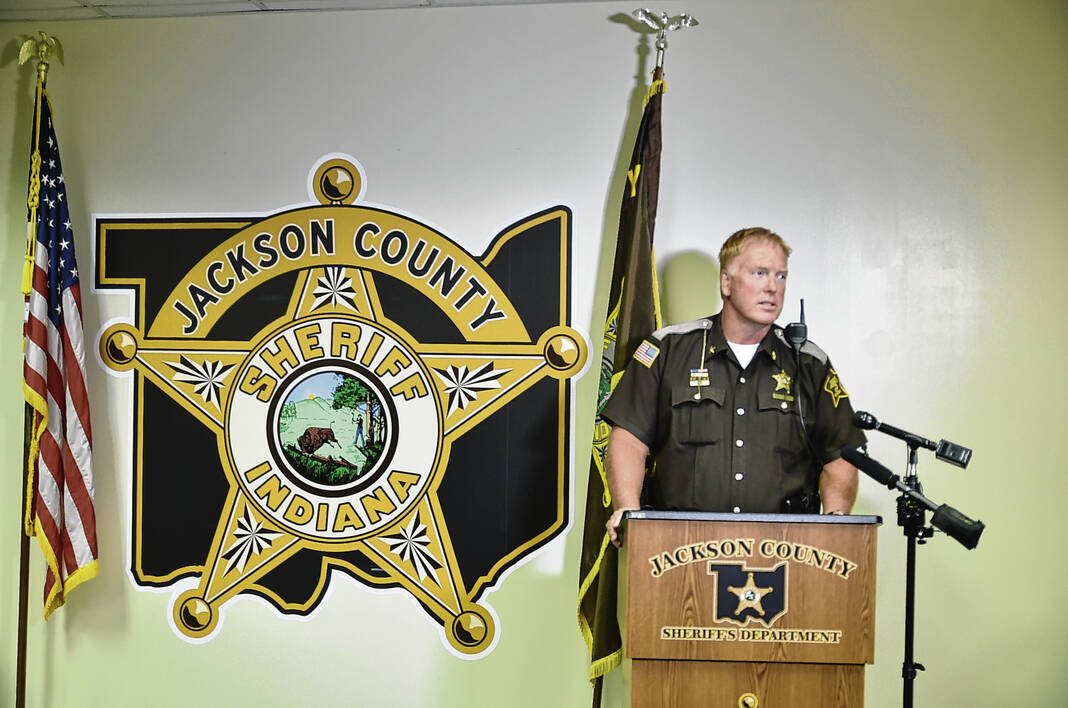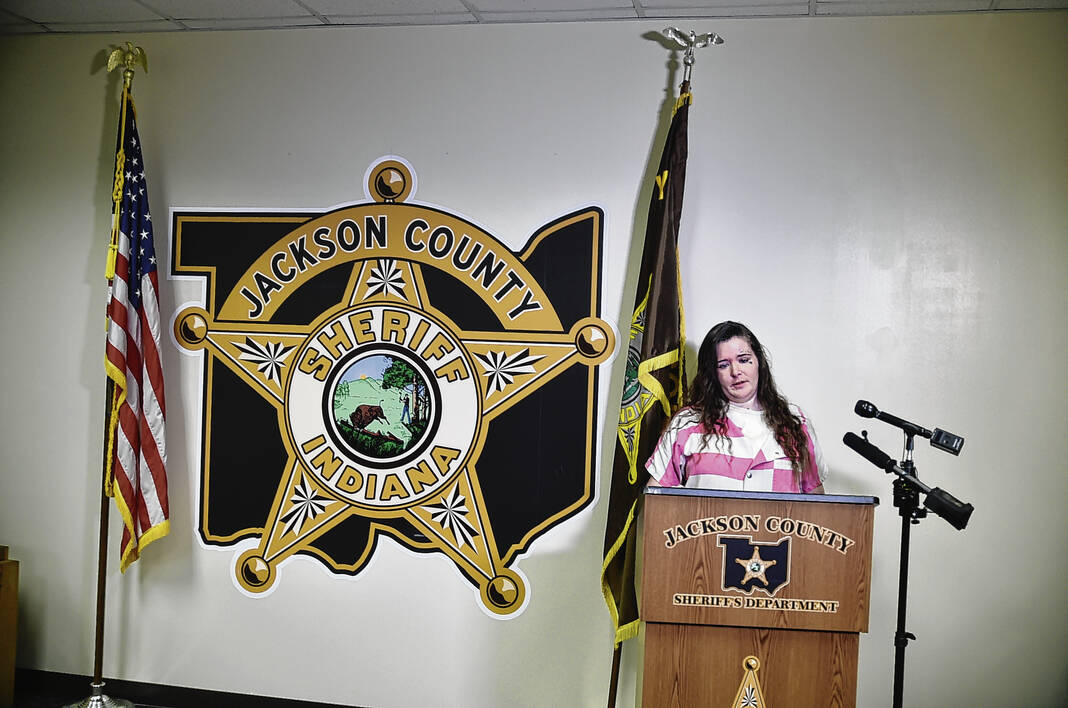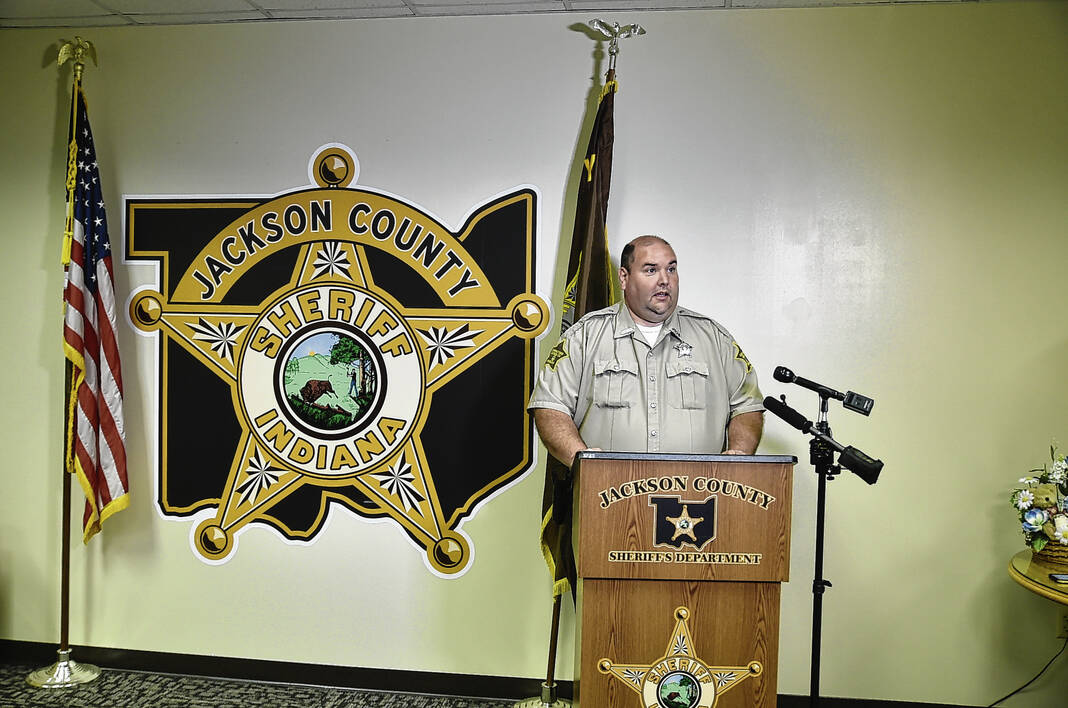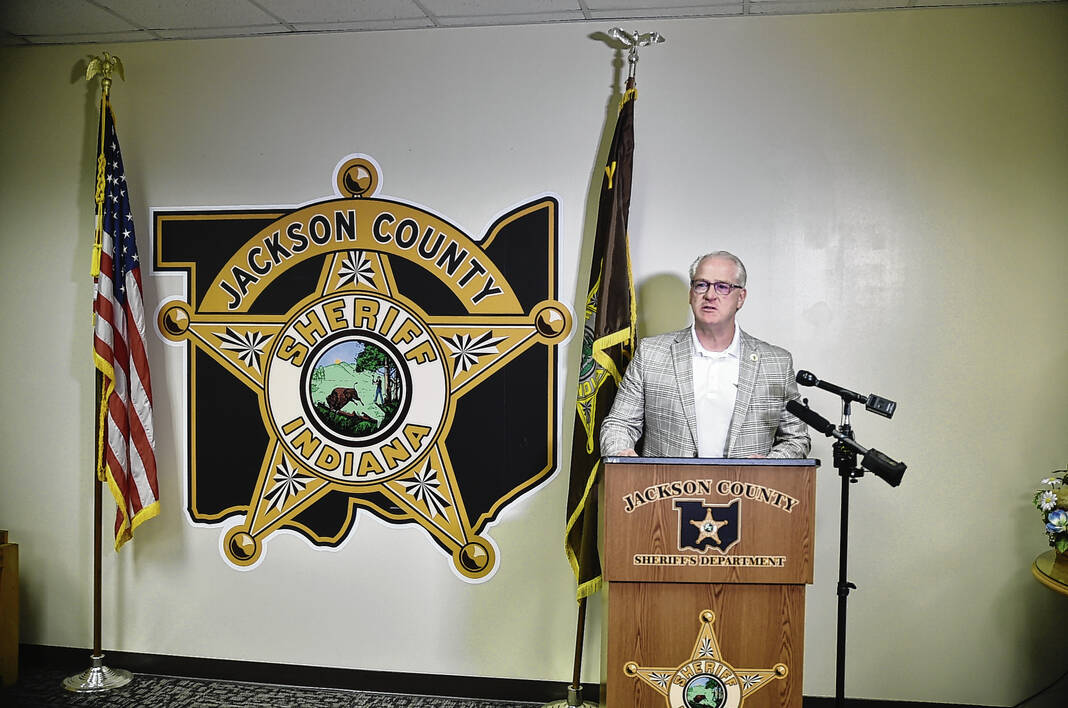
The Jackson County Jail is located at the Jackson County Sheriff’s Department at 150 E. State Road 250, Brownstown.
Tribune file photo

Jackson County Sheriff Rick Meyer talks about a new program to treat substance use in and out of jail during a press conference Wednesday afternoon at the Jackson County Jail in Brownstown.
Erika Malone | The Tribune

Jackson County Jail inmate Karley Elsner shares her personal story on how she has benefited from the treatment program so far during a press conference Wednesday afternoon at the jail in Brownstown.
Erika Malone | The Tribune

Jackson County Jail Commander Chris Everhart talks about the day-to-day process of the new treatment program during a press conference Wednesday afternoon at the jail in Brownstown.
Erika Malone | The Tribune

Douglas Huntsinger, executive director for drug prevention, treatment and enforcement for the state of Indiana, speaks on how the initiative started during a press conference Wednesday afternoon at the jail in Brownstown.
Erika Malone | The Tribune

Steve Luce, president of the Indiana Sheriffs’ Association, spoke about the program during a press conference Wednesday afternoon at the jail in Brownstown.
Erika Malone | The Tribune
BROWNSTOWN — For many incarcerated individuals, substance use played a role in how they ended up in the correctional system.
Now, these individuals have the opportunity to begin their recovery journey with a new drug treatment program while they serve their time.
“A majority of our inmates have addiction problems,” Jackson County Sheriff Rick Meyer said. “They don’t want to be addicts, and sometimes, they can’t fix it on their own.”
During a press conference Wednesday at the Jackson County Jail in Brownstown, Meyer announced Jackson County will join 39 Hoosier counties in offering a new Medication Assisted Treatment Opioid Program, also known as MAT, for treating people in jail who suffer from opioid use disorder.
This program was adopted by the sheriff’s department in partnership with the Indiana Sheriffs’ Association and Centerstone, a nonprofit health system specializing in mental health and substance use disorder treatments for people of all ages.
The program is funded by the Indiana Family and Social Services Administration’s Division of Mental Health and Addiction.
“When an individual with a substance use disorder is booked into Jackson County Jail, we’re now equipped with the tools to stabilize them, properly treat their disease and support them on their path to recovery,” Meyer said. “Jackson County may be a small, rural community with limited resources; however, this program is proof that we can still make a large impact.”
Karley Elsner, an inmate at the Jackson County Jail and the first recipient of Jackson County’s MAT program, SOAR, which stands for succeed, overcome and recover, had been using drugs since she was 13.
Elsner now faces 36 years in prison for using and selling drugs, but since being in the MAT program, she is focused on the steps in her recovery.
“I feel what I believe is normal for the first time since I was 13 when I started using hard drugs,” she said during the press conference.
Meyer said he and the jail staff want to help inmates start a happier, healthier life after they leave there.
Meyer then welcomed Douglas Huntsinger, executive director for drug prevention, treatment and enforcement for the state, to speak on how the program got started.
“When Gov. (Eric) Holcomb declared the drug epidemic a top priority in 2017, he did so knowing that it would require a comprehensive community-based approach,” he said. “Under the governor’s leadership, we built a statewide infrastructure that cares for the whole individual with touch points strategically placed at every step of their recovery.”
Huntsinger said in 2019, a partnership with the Indiana Sheriffs’ Association and the state was formed. Since that time, the program has been able to treat 4,400 Hoosiers across 39 county jails through a $6 million investment.
Huntsinger said the program doesn’t just end with medication treatment.
“Regardless of how they ended up in the correctional system, it’s how they move forward is what matters most,” he said.
With the support of Schneck Foundation and Centerstone, people with substance use disorder in the Jackson County Jail will have the opportunity to connect with peer recovery coaches to aid them in their recovery and re-entry upon release.
“With more than 80% of individuals in the justice system having a diagnosable substance use disorder, jails are ground zero for helping people restart their lives,” Huntsinger said. “Today, Jackson County takes an important step toward improving outcomes and making recovery possible for the incarcerated population.”
Jackson County was a recipient of a Comprehensive Opioid Recovery Center grant from Centerstone. The grant is part of a $3.4 million four-year award from the Substance Abuse and Mental Health Services Administration to provide a full spectrum of treatment and recovery support services to residents in nine of the state’s 92 counties.
Steve Luce, president of the Indiana Sheriffs’ Association, said one thing he found unique during the governor’s meeting in 2019 was that Indiana was the only state to include jails in the strategic plan.
“We have a great opportunity to bring communities together,” he said.
Luce said some of the duties the association has in regards to maintaining the program is to regularly communicate with sheriffs and community partners with the initiative, work on updating policies throughout the implementation process and facilitate three events to educate and engage the sheriffs and staff.
Luce said the biggest part of his job is serving as a liaison between the state and the county sheriffs.
“We are in the business of building communities with trust, and the way we do that is through strong partnerships, and what that’s going to do is give our communities hope,” he said “Not everybody in jail is a bad person. They’ve just got their life on pause, so it’s our job to get them back and integrated with the community so themselves and their families have hope again.”
Lindsay Sarver, a community health improvement strategist with Healthy Jackson County, said the integration of peer recovery services will change the lives of not only those who struggle with addiction but with their families, friends and neighbors.
“Recovery looks different for each person, as does their path,” she said. “For some, it’s a 12-step meeting and full abstinence. For others, it’s in-patient treatment, and still others, a path through the correctional system.”
Sarver said Schneck Medical Center’s medication for opioid use disorder program currently boasts an 89% sustained recovery success rate for its patients, which is at the top of its national average.
These are life-changing numbers, said Sarver, who also works for Schneck.
“Medication assisted treatment is reducing the burden of disease on each individual and also on our community,” she said.
Jail Commander Chris Everhart said providing the program at the jail has been a goal of his for a number of years.
He said Jackson County is the first in the state to utilize the prescription drug Sublocade as a medication to help treat opioid use disorder.
“The reason we selected Sublocade was after some research and talking to some other department in Ohio, we learned that they were having a great success rate using Sublocade,” he said.
The jail started the MAT program in February and administered its first dose of Sublocade in April. The once-a-month injection will stay in the individual’s system for two to five months. Everhart said so far, the jail has treated four individuals through this program.
“We have had some success with just being able to provide some of the clients with the medication,” he said. “They just have hope.”
Everhart said in one instance, they had a gentleman with several warrants turn himself in once he learned he would be able to enroll in the MAT program.
“We are already seeing positive changes and impacts in the community,” he said.
Everhart welcomed Elsner to the podium to speak on her success with SOAR.
“Being on the shot myself has helped me focus on the next step instead of my next fix,” she said.
Since starting the program in February and with the classes she takes with a recovery coach twice a week, she said she learned more about herself, her addiction and resources, and ultimately, she is not alone in her journey.
“I feel this program has really changed my life,” she said. “To stop recidivism, we need to help addicts recover with medicine and knowledge instead of locking them up, drying them out and throwing them back into society with no plan, no resources and no knowledge about who they are or what they can accomplish.”
Elsner said the MAT program is the ticket to change and save lives for those like herself who want to break the cycle of addiction.
